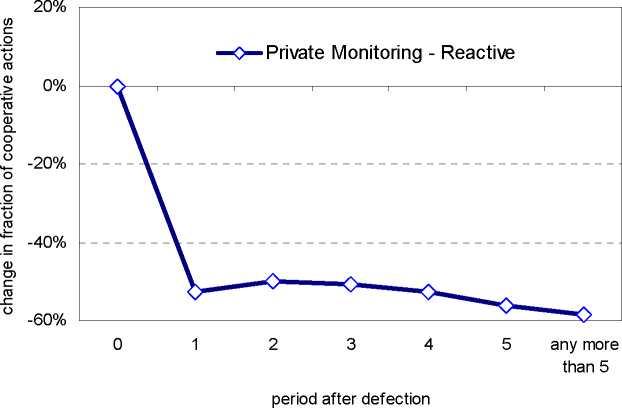subject. The specific choice of regressors is one among many possible ways to trace
strategies. One advantage is to detect whether subjects followed theoretically well-known
strategies such as grim trigger or tit-for-tat (Axelrod, 1984). For simplicity our strategies
embed a maximum delay of five periods. The grim trigger regressor13 has a value of 1 in
all periods following an observed defection and 0 otherwise. The five tit-for-tat
regressors have a value of 1 only in one period following an observed defection and 0
otherwise. The first takes value 1 in the period immediately following the defection. The
second takes value 1 in the second period following a defection, and so on.
If subjects switched from a cooperative to a punishment mode following an observed
defection, we expect at least one of the strategy regressors to be negative. For example, if
subjects punished for just two periods following a defection, we expect the sum of the
estimated coefficients of the grim trigger regressor and the tit-for-tat regressors to be
negative for the first and second period following a defection, and zero afterwards.
Figure 5: Strategies of the representative subject in private monitoring

13 We label a regressor “grim trigger” because it reminds us of the well-known grim trigger strategy, which
specifies a permanent shift to punishment following a defection.
23
More intriguing information
1. Unilateral Actions the Case of International Environmental Problems2. The name is absent
3. Confusion and Reinforcement Learning in Experimental Public Goods Games
4. Word Sense Disambiguation by Web Mining for Word Co-occurrence Probabilities
5. The name is absent
6. A Study of Adult 'Non-Singers' In Newfoundland
7. XML PUBLISHING SOLUTIONS FOR A COMPANY
8. Convergence in TFP among Italian Regions - Panel Unit Roots with Heterogeneity and Cross Sectional Dependence
9. Telecommuting and environmental policy - lessons from the Ecommute program
10. Cyclical Changes in Short-Run Earnings Mobility in Canada, 1982-1996